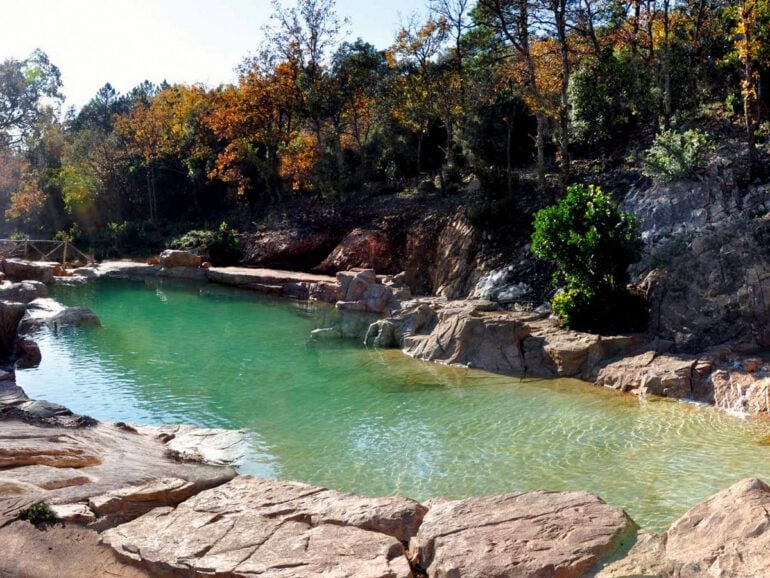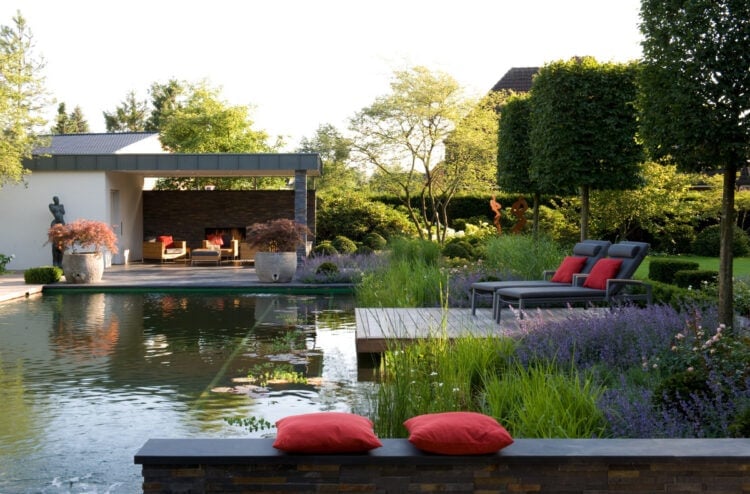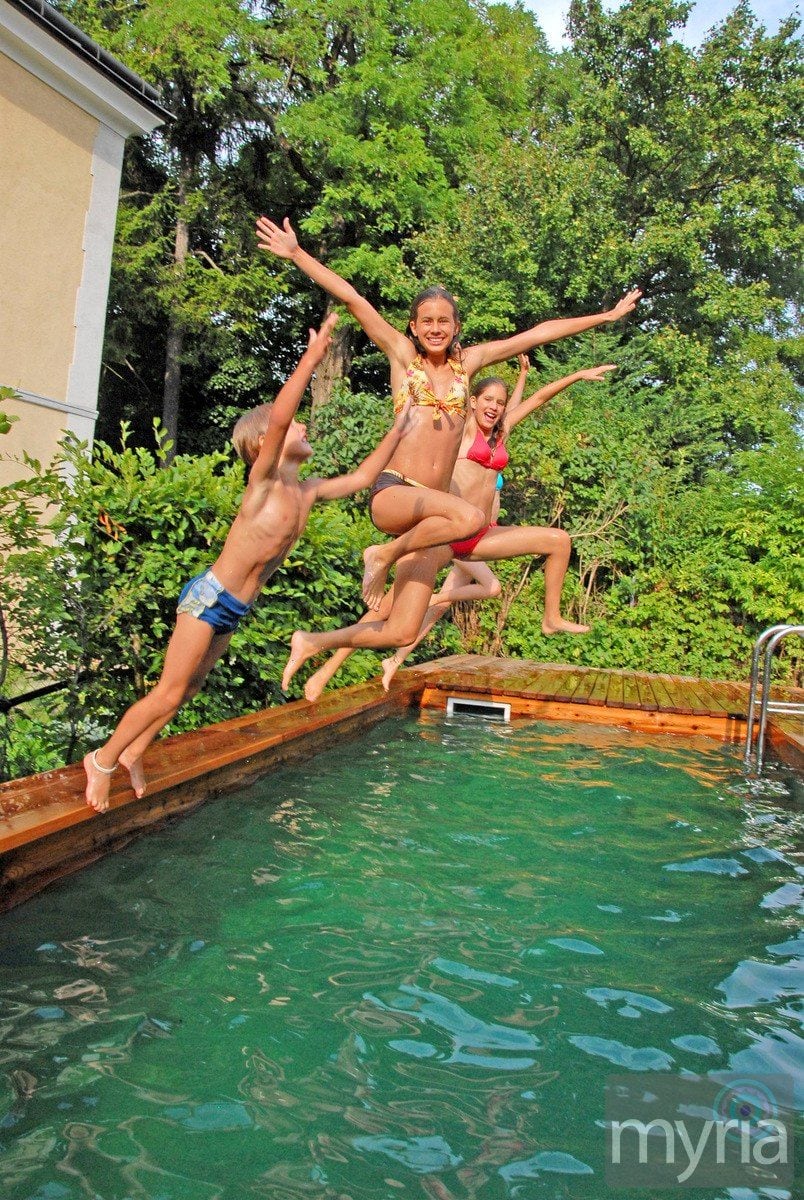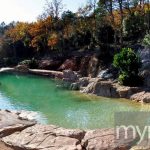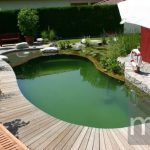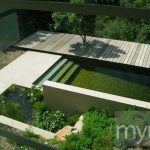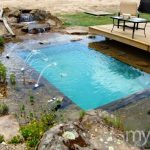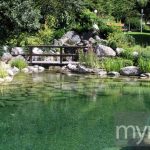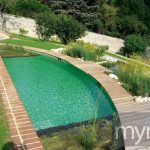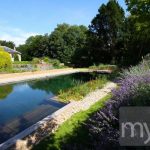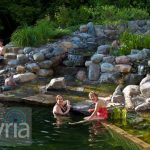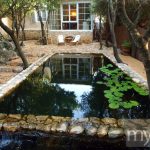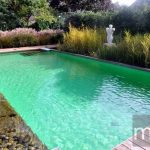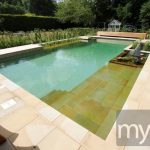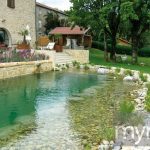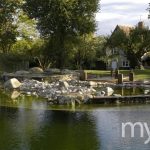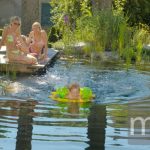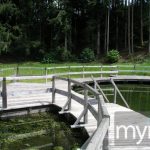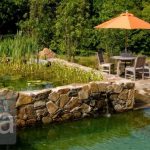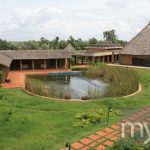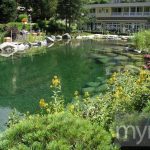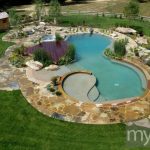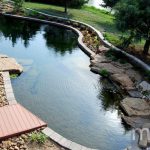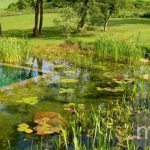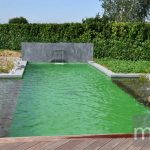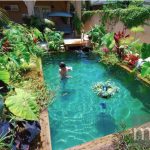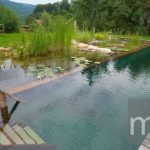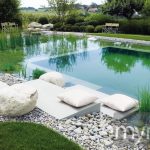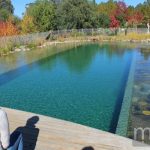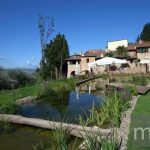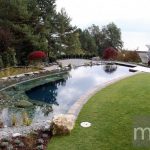Do you love to swim, but hate the smell — and eye burn, hair damage, skin dryness and swimsuit fading — you get every time you jump into a chlorinated pool?
A natural swimming pool might just be the answer for you.
A natural swimming pool (NSP) is an alternative to the typical chemically-treated swimming pool concept. Like their commonplace counterparts, the natural pools are specifically constructed to contain water — meaning they don’t have muddy or sandy bottoms or sides.
In fact, some pools can look very much like the gunite-bottomed swimming holes Americans have come to know and love over the decades, while others have much more of a pond or creek vibe.
But what’s really different is how these pools clean and filter themselves. Instead of the water being disinfected and sterilized by chemicals (such as chlorine), it is instead clarified and cleaned by hydroponically-rooted plants that feed on the nutrients in the water — made possible by a pump feeding a natural filtration system.
The plants are kept separate from the swimming area — in what’s termed a regeneration zone — through which the water from the pool flows, nourishing the plant life.
More technically, “A natural swimming pool is a balanced wetlands ecosystem based on the principles of limnology, hydraulics, hydroponics, and modern pool construction methods,” notes BioNova, who brought natural swimming pool construction to the US in 2008.
How does a natural pool avoid getting swamp-like?
So how, exactly, does that explain the way a natural swimming pool will stay clean? “The water is treated biologically. There are no chemicals used, nor are there any devices used that would disinfect or sterilize the water,” says BioNova.
“The movement of the water through the biological filter, the action of the aerobic and anaerobic bacteria in the filter and regeneration zone, as well as the plants feeding hydroponically on the water, is how the water is cleaned.”
The Biotop Natural Pool Company in Germany, one of the first to build these unique sustainable pools, notes that the ratio of the swimming zone to the regeneration zone is generally 1:1, and the depth is at least two meters [6-1/2 feet] in the swimming area.
“This is the basis for a functioning pool. If more technology is used, the regeneration area can be smaller with less depth.” They further note that their pools are “inoculated with zooplankton (water fleas, rotifers, paramecia), which play an important role in the cleaning process. All it takes is a little bit of patience until the pool finds its balance.”
Patience, and a little TLC. BioNova says that some aspects of maintenance are the same as for a traditional chemical pool. “We need to periodically empty and clean skimmer baskets, empty and clean pump baskets, vacuum the pool and clean the filter. Water garden maintenance is also necessary — removing unwanted plants, trimming and maintaining existing plants, and cutting them back at the end of the season.”
The origin of man-made natural swimming pools
The first NSPs were built in the early 1980s in Austria, and by the mid-1980s, companies in Austria and Germany began creating natural pools for homeowners. Slowly, the market spread throughout Europe — where they’re often called “natural swimming ponds” — and the concept first made a splash in the US when the New York Times wrote about the pools in 2007. It’s taken a few years, but now the trend is heating up stateside.
America’s heat, though, does change the business a bit, since it’s actually hotter in many states than it typically is in the regions around Berlin and Vienna.
A natural swimming pool offers a slice of suburban paradise
Mick Hilleary, President and Designer at Kansas-based Total Habitat explains how the pool construction and systems need to be adapted to suit to different environments. “Plants alone, even in expansive zones, don’t provide the cleaning horsepower needed for the warmer climate we have here in the USA,” he says.
We love water plants, but technically, it’s the beneficial bacteria that cleans the water — the more living space you give them, and draw water through, the more nasty stuff they consume.”
Even with extra filtration power needed, natural swimming pools are still a very eco-friendly and sustainable option. They only need to be filled once, don’t leach chemicals into the environment (or into you), and use power efficiently.
And, perhaps be best of all, these man-made “swimming ponds” offer homeowners a uniquely tranquil experience. As Peter Petrich, owner of Biotop, says of his creations, “A natural pool is an image of nature that one can have in one’s own garden, a biotope that exists in the lively cycle and interplay of plants and animals.”
Natural swimming pool photo gallery
As these 30-plus photos demonstrate, a new kind of backyard oasis is growing in popularity worldwide: natural swimming pools, or NSPs.
You can think of these pools as Mother Nature, managed: no fish, no chlorine, no dirt, no algae… but plenty of clear water, along with some beneficial bacteria, frogs and harmless aquatic insects.
Photo gallery: 32 eco-friendly natural swimming pools
The beginnings of the NSP movement
Biotop, the Austrian company that is credited with inventing the original natural swimming pools three decades ago, has since built thousands of pools with its partner companies around the world.
Peter Petrich, MD of Biotop says that worries about chlorine-treated pools were a driving force behind starting the business. “These concerns are one of the reasons we invented the natural pool 30 years ago, so that people can swim in crystal clear water entirely without chemicals and feel at one with nature, in the safety of their own gardens.”
The company looks back to history for proof-of-concept. “In the 1900s, prior to the industrial revolution when the first indoor public bathing pools were built, people of all ages would only ever swim in the natural waters of rivers, lakes and canals. This natural approach to swimming has started to see something of a renaissance in recent years with a growing desire by swimmers to experience the pleasures and health benefits of natural water.”
Petrich adds, “Whereas many customers originally wanted a natural pool with a planting regeneration zone, for the year-’round beauty they provide, we have seen increasingly more requests from customers who are very interested in the positive health benefits of natural water swimming.”
Do natural swimming pools cost more than traditional pools?
In general, yes, according to BioNova Natural Pools. “These pools cost about the same per square foot as a traditional chemical pool, but because these pools are larger they will tend to cost more, typically starting out in the high five figure range,” they say — and also note that their company recommends a natural swimming pool be at least 535 square feet. “Additionally, natural pools need to have the aquatic plants acquired and installed.”
The team at Total Habitat, an innovator in the US natural pool market, breaks down the cost in a little more detail. “A 50′ x 50′ natural swimming pool, with a 30′ x 30′ swimming area, dock and waterfall, complete with starter plants, generally runs $34,000 to $45,000, depending on access, soil type, etc,” they note.
“For the materials alone, this same pond has $22,000 to $24,000 worth of pumps, liner, plumbing, wood, stainless steel screws, skimmers, waterfall parts, UV sterilizers, filter media stones, landscaping boulders, starter plants and electrical conduit, wire, GFI outlets, lights and timers. The rest of the cost is excavation, equipment rental and the labor to put it together.”
“Ongoing operational costs are lower over the years as no chemicals are needed, and energy consumption is much lower than for a chemical pool,” BioNova adds, and reminds homeowners weighing the costs to keep in mind that a NSP is a swimming pool and a water garden in one.
And as a bonus: even though the pools are growing in popularity, you’re still very likely to be the only one on your block — or maybe your entire county — with one of these beauties.

